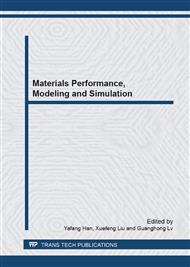[1]
RAN Guang, ZHOU Jing-en, WANG Yong-fang, XI Sheng-qi. Microstructure and Tensile Properties of Cast A356 Aluminum Alloy. HEAT TREATMENT OF METALS; 2007, Vol. 32, No. 3: pp.13-17.
Google Scholar
[2]
Yi You-fu, Long Siyuan, Xu Shaoyong, Wang Ruifei, Tang Xiaoliang. Microstructure and Mechanical Properties of Low-pressure Casting A356 Aluminum Alloy Wheel Hub. SPECIAL CASTING & NONFERROUS ALLOYS; 2008, Vol. 28, No. 5: pp.373-375.
Google Scholar
[3]
DAI Xue-rui, LIU Jin-hai, LU Su-ling, LI Shuang-shou, ZENG Da-ben, TANG Bin. Simulation of Casting Stress of Low-pressure Casting Aluminum Alloy Wheel. FOUNDRY TECHNOLOGY; 2009, vol. 3, No. 11: pp.83-86.
Google Scholar
[4]
FENG Xu-dong, WANG Rui-quan, YANG Gang, WANG Jin-yong. Numerical Simulation of Filling and Solidification Process for Aluminum Wheel Hub by Low-Pressure Casting and Technology Improvement. FOUNDRY TECHNOLOGYy; 2010, Vol. 3, No. 13: pp.332-335.
Google Scholar
[5]
LIU Wenzhong, XIONG Qian, JIANG Yu. Finite Element Simulation of Uniaxial Tensile Necking Instability of Copper Alloy. Hot Working Technology; 2011, vol. 40, No. 14: pp.20-23.
Google Scholar
[6]
JIA Xiao-fei, WANG Zhi-feng, ZHAO Wei-min, ZHAO Yang, ZHANG Liang. Defects Analysis and Prevention Measures of Low Pressure Die Casting of A356 Aluminum Alloy Wheels. CHINA FOUNDRY; 2010, vol. 59, No. 12. pp.1298-1302.
Google Scholar
[7]
LIANG yong, LIU Hong-lei, ZHENG Bao-quan, LIU Zhi-feng, YU Bao-man. Effect of Multi-aging on Mechanical Properties of Die-cast A356. 2 Aluminum Alloy Wheel. FOUNDRY TECHNOLOGY; 2009, vol. 30, No. 4: pp.587-589.
Google Scholar
[8]
JIA Pan-jiang, TANG Hui, CHEN Bang-feng. Effect of Casting Methods on Mechanical Properties and Fracture Surfaces of ZL210A Casting Aluminum Alloy. JOURNAL OF MATERIALS ENGINEERING; 2008, No. 1: pp.30-33.
Google Scholar
[9]
WANG Rong-bin. Analysis on the Defects of As-cast Aluminum Alloy and Investigation of Heat treatment. FOUNDRY TECHNOLOGY; 2008, Vol. 29, No. 4: pp.524-526.
Google Scholar
[10]
WU Yanqing, ZHANG Keshi. SIMULATION OF COARSE-GRAINED LY-12 QUASI-SUPERPLASTIC UNIAXIAL TENSION. ACTA MECHANICA SOLIDA SINICA; 2003, Vol. 24, No. 3: 314-320.
Google Scholar
[11]
Mattia Merlina, Giulio Timellib, Franco Bonollob, Gian Luca Garagnania. Impact behaviour of A356 alloy for low-pressure die casting automotive wheels. JJournal of Materials Processing Technology; 2009, vol. 209, NO. 2: pp.1060-1073.
DOI: 10.1016/j.jmatprotec.2008.03.027
Google Scholar
[12]
Chia-Lung Chang, Shao-Huei Yang. Simulation of wheel impact test using finite element method. Engineering Failure Analysis; 2009, Vol. 16, No. 5: pp.1711-1719.
DOI: 10.1016/j.engfailanal.2008.12.010
Google Scholar
[13]
H. LAKSHMIa, M.C. VINAY KumaRrb, Raghunatha, P. Kumara, V. Ramanaray, K.S.S. Murthya, P. DUTTAa. Induction reheating of A356. 2 aluminum alloy and thixocasting as automobile component. Transactions of Nonferrous Metals Society of China. 2010, vol. 20, No. 3, pp.961-967.
DOI: 10.1016/s1003-6326(10)60614-0
Google Scholar


